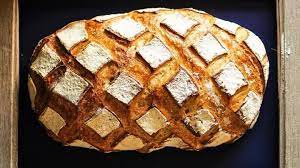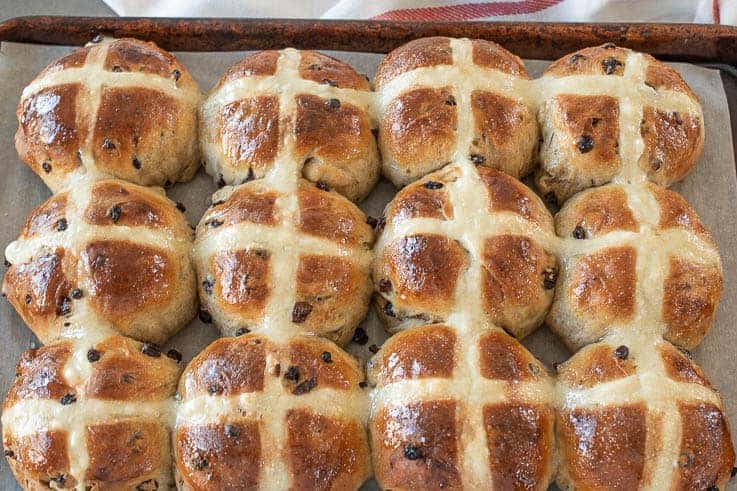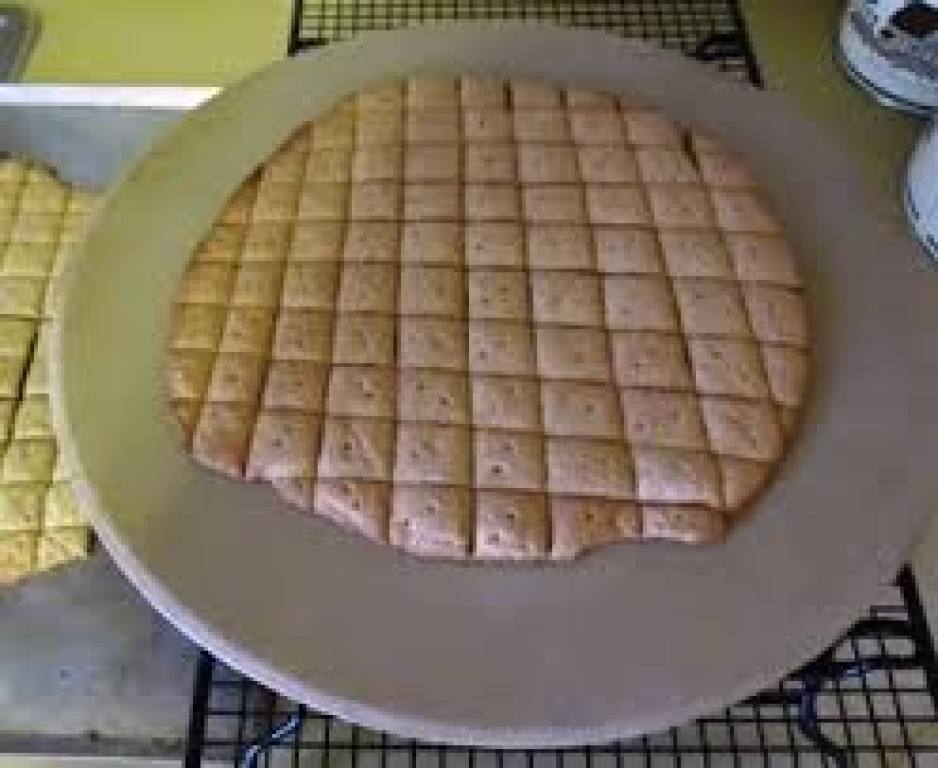Which one of these things is not like the others?
A) Cross-hatched loaf. Get a a little cheese, some slices of sausage, some wine… what’s not to like?

B) Hot Cross Buns. Hot from the oven! Yum.

C) The “bread” at the “cluster” in the Archdiocese of Milwaukee at St. Joan’s and St. Catherine’s (recently featured HERE). They have their own bread ministry. Often referred to by libs as “substantial bread”. It’s more meaningful, you see, because it looks nothing like a cow pie run over by a tractor, but like real bread. Doesn’t it make you think of bread? Immediately? Consider the joiys of the texture! Something like dried particle board. Meaningful. So are all the particles that scatter pretty much everywhere, uncontrollable.

D) Making hosts at St. Agnes Church in St. Paul for all the parish Masses.
Speaking of “substantial bread”…
ANECDOTE: In my seminary in the USA – a horrible place filled with heresy and the black grief of the world – we had “substantial bread” that was so hard, so impossible to get down that even the liberals (the majority) complained about it. We received back the answer from the faculty that – I am NOT making this up! –
“The longer you chew, the more of a sacrament it is.”
To this day, that remark remains one of the stupidest things I have ever heard in a Catholic context.


































Given the aforementioned and the fact that they are still using the old form of consecration, wouldn’t that be enough to raise the issue to the Bishop and force them to at least correct that? I thought Wisconsin was more of a conservative traditional Catholic state?
This “substantial bread” is what I received at my First Holy Communion in the 1980s. I distinctly remember large crumbs covering my hands, and my little 8 year old brain went into a panic. As reverently as possible, I licked my hands so as to not let any part of Him fall on the floor or on my dress. To this day, I get a pit in my stomach whenever I think about it.
“The longer you chew, the more of a sacrament it is.”
“Mr. Madison, what you’ve just said is one of the most insanely idiotic things I have ever heard. At no point in your rambling, incoherent response were you even close to anything that could be considered a rational thought. Everyone in this room is now dumber for having listened to it. I award you no points, and may God have mercy on your soul.”–The Principal, Billy Madison
As a faithful son of the Church in Milwaukee, the earlier post about the cluster, as well as this new post on the “bread ministry,” strikes a particular chord for me. As an earlier person noted, Milwaukee is one of those rare (arch)dioceses where you really can experience the gamut of liturgical life, from our wonderful Institute priests at St. Stanislaus (as well as our faithful secular clergy offering the Mass of the Ages at many parishes around SE Wisconsin), through reform-of-the-reform Novus Ordo parishes (one of which I am blessed to call home), faithful Melkite Divine Liturgy and the Holy Resurrection monastery in St. Nazianz, all the way down to this nuttiness. I had hoped that this latter example of the Groovy Years had, for the most part, ended, but these posts show me it has not. If the NO is supposed to foster unity of the Latin Church, here we have in microcosm disunity. I am just thankful that I “know where to go” for solid worship, orthodox homilies and Confessors, etc., and now I have another couple of parishes to add to my “No Fly List.”
These people make fun of the “old Mass” with its specific rituals and yet spend gobs of time making up stuff to be relevant and cause the same “feelings” and results they imagine the TLM evokes.
For example, the slow timed walking of the readers to the altar to read. Or the carrying of extra stuff up while bringing up the “gifts”.
It seems to me the NO must be somewhat empty to them if they must spend time & effort to infuse it with ” meaning” by using “substantial bread” and creative ad-ins to the Mass.
The Eastern Churches use something more like that so-called “substantial” bread…but they receive communion on the tongue from a spoon and there’s no chance of any part falling or staying on someone’s hand.
I don’t understand how you made it through the Seminary. Either you would have left to maintain your faith and sanity, or you would have been expelled as hopelessly rigid and retrograde.
That horrible stuff! The second worst was the incompletely-baked bread they used at my parish in Missoula (MT) 30 years ago. It also left crumbs everywhere, but on top of that it was indigestible — not just hard to ingest but almost impossible to digest.
Our current Bishop of Helena doesn’t allow sacrilege like that.
Great video; very interesting! Thanks for posting, Fr. Z. May God bless you and your work.
I like how, when they already decided they could do anything, they chose to make the “altar bread” as slap-dash as possible. If any less effort had been put in they would have just furnished their “liturgy” with a bowl of flour.
With respect to the comment about chewing, however, it is a very revealing and consistent statement on their part. For you see, we view God’s grace as a free gift which we receive (because we’re neopelagians, obviously), whereas Fr Z’s formation team were, I am sure, Kantians (although probably unwittingly): for Kant, it’s the effort that counts, all merit is derived from effort, and this effort is a part of “meaningfullness.”
I know it was a thing back during first communion to have us prepare the communion bread beforehand, but my recollection is that it was much closer to the St. Agnes bread than the St. Joan bread.
I’ve never seen anything other than a thin white wafer in this diocese thankfully, though I do occasionally worry about sourcing as I know the “gluten-free” variety have occasionally been advertised but always explained away as a “typo” when questioned.
Is the “cluster bread” as shown in the pic licit according to the norms of the Church? Our proper ingredient wafer hosts as shown in Fr. Z’s option D do not rise. “Cluster bread” has risen, so to speak – possibly indicating additional illicit ingredients. Can someone help me with this? Thanks
When I was a freshman at the U of MN back in 1995 the Newman Center did communion bread like that one in C. I wasn’t as knowledgeable in my catechism as I am now so I didn’t recognize the issue of it, but yes there were crumbs all over the baskets of them. It is a really horrible idea. They also had lay people doing sermons and lots of other weirdness. By my junior year the Bishop had shut them down and we had to go to St Lawrence over in Dinky Town.
Even Dorothy Day mourned over the use of this “substantial bread” by the Berrigan Brothers.
As someone who frequently attends Eastern Catholic Divine Liturgies, please don’t confuse the leavened loaf used by the Eastern Churches with this tragic “substantial bread”.
One of the most unfortunate aspects of modern life is the prevailing assumption that the practices of past generations (i.e. the design of altar breads) were not already thoroughly considered and quite logical and, most importantly, best *left unchanged*.
Pingback: MONDAY EDITION – Big Pulpit